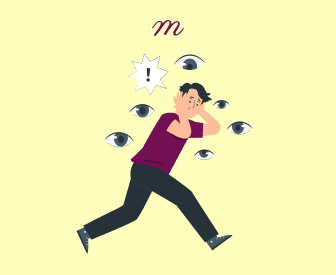Have you ever felt overwhelmed by sadness, fear or worry? This can happen when you're thinking about certain places, activities, or people. These thoughts affect your emotions and reactions. They can make you withdraw, feel anxious, or be hard on yourself. Sometimes, it can cause you to feel frustrated and even have anger outbursts.
Cognitive restructuring can help you deal with these unhelpful thoughts that cause emotional distress. In this blog, we'll talk about cognitive restructuring and how it works. You'll find valuable tips on how to use it to deal with negative thoughts and improve your mental health.
What Is Cognitive Restructuring?
Cognitive restructuring is a therapeutic technique that helps you identify, and change negative thoughts. It promotes positive thoughts, feelings and actions. This technique focuses on replacing irrational thoughts with more balanced ones.
It is important to note that negative thoughts can be automatic or intrusive. Automatic thoughts come from your daily habits, they are easier to manage. This is because they cause less emotional stress. But, intrusive thoughts are more upsetting. They seem to come out of nowhere and are harder to control.
How Does Cognitive Restructuring Work?
The goal of cognitive restructuring is to challenge and change distorted thought patterns. Cognitive restructuring helps you break free from the cognitive distortions.
Some of these cognitive distortions include:
All-or-Nothing Thinking
This is a situation where you view things in extremes. In this case, it is either black or white, success or failure, right or wrong. You don’t leave any room for middle ground.
For example, you think:
“I got a B on my test, I'm a total failure."
“I didn’t win an award at work, I’m a bad employee.”
“All doctors are mean.”
“My wife forgot my birthday, she doesn’t love me."
Overgeneralization
This occurs when you begin to make broad interpretations from a single event. Then, you begin to apply your interpretation beyond the situation to other events.
For instance, you think:
“I didn't pass this interview, I'll never get a job.”
“I missed a shot in basketball last week, I always mess up in games.”
Mental Filtering
This is a situation where you choose to focus only on the negative aspects of a situation. Then, you ignore all the positive aspects.
For example, you get eight compliments on your project. But you can only remember the one critique you received.
Discounting the Positive
This is a case where you keep rejecting your positive experiences. You will rather insist that they don’t count.
For example, you dismiss a compliment made by your manager at work thinking it was just luck. Or your teacher praises your essay, but you think, "They’re just being nice; the essay wasn’t good.”
Jumping to Conclusions
This distorted thinking pattern makes you have negative interpretations of events without evidence. You begin to engage in mind reading (where you assume that others are thinking negatively about you). In other cases you start fortune-telling (you begin to predict that things will turn out badly).
For instance, you see your friends laughing and assume they’re laughing at you. Or, you didn’t get a reply to a text you sent to your friends and you think, "They must be mad at me."
Magnification (Catastrophizing) and Minimization
This involves exaggerating problems or downplaying the importance of a situation.
For example, you say “I lost my wristwatch, my whole day is ruined now."
When minimizing a situation, you might say, “I wasn’t insulting you, I was just joking.”
Emotional Reasoning
This is a cognitive distortion where you believe your negative emotions reflect the truth of a situation.
For example, "I feel anxious about this relationship, so I think we should break up." Or “Everyone keeps looking at me at parties, I feel like they hate me.”
Should Statements
This is where you keep emphasizing how you or others "should" behave. Most times, it makes you feel either guilty or causes frustration when your expectations are not met.
For Instance, you’re thinking:
“I should always be productive and successful.”
“I should be promoted instead of my colleagues.”
“My sister should be smart enough to get into college.”
Labeling and Mislabeling
This involves judging people based on their mistakes or shortcomings. Then, you address them based on a negative attribute you have seen or inaccurately label them.
For example, you might think:
“She spilled her coffee, she must be dull and dirty.”
“He came to work late, he must be lazy.”
“He didn’t submit his math test in time, he must be bad at math.”
“She did not put in her best in the game, she’s a loser.”
Personalization
This is a type of cognitive distortion where you take the blame and feel responsible for every negative situation. For instance, believing that you are the cause of someone else’s bad mood.
You might also think:
“My child is getting bullied because I left him alone in school.
“My father hit me because I made him upset.”
My friend is angry today; it must be because of something I did."
Cognitive Restructuring Techniques and Examples
Cognitive restructuring is not a "one size fits all." It is not the same for everyone. Therapists use different techniques based on individual needs. These techniques aim to adjust your thinking. Such changes lead to a balanced and positive thinking pattern. Some of the techniques in cognitive restructuring include:
The Three Cs of Cognitive Restructuring
For you to get a better grasp of cognitive restructuring, you can learn the three C’s of cognitive restructuring. These three C’s are the steps involved in cognitive restructuring. They are Catch, Check and Change. We will analyze these in detail so that you can understand them better.
1. Catch – (Identifying Negative Thoughts): This phase aims to bring you into awareness and consciousness of your thoughts. Most times, people get into cycles of negative thoughts without paying attention. Repeated occurrence of such cycles leads to emotional stress and negative behavior. Catching your thoughts positions you to consciously address your thoughts as they occur. 2.
For example, you’re thinking, "I'm not good enough," or "Everything will go wrong." It's important to catch these thoughts as they happen. If your school group is planning mountaineering and you keep getting anxious about it. When you “catch” your thoughts, you might realize it's because you are afraid of missing a step and falling off.
You might ask, how do I catch negative thoughts? One of the ways you can catch negative thoughts is through self-monitoring. As you go about your day, pay close attention to your automatic negative thoughts and emotions. Make it a habit to pause at intervals to reflect and document your thoughts in a thought diary.
You can also catch negative thoughts by paying attention to your emotional triggers. Most times, strong and intense emotions are a signal to a deeper thought. When you feel intense emotions like anger, sadness and anxiety, it is time to pause to find out the negative thoughts.
Another way to discover negative thoughts is by searching out recurring patterns in your thinking. Look out for recurring negative thoughts in your mind. When you can identify such thoughts, you have successfully made progress and performed the first step in cognitive restructuring.
2. Check – (Challenge Negative Thoughts)
This is the next phase in the cognitive restructuring process. In this phase, you will check the thoughts you have identified. Evaluating the thought will help you analyze the thought. Is it realistic, distorted or based on evidence? Cognitive distortions are errors in thinking that lead to negative emotions. They include the all-or-nothing thinking, overgeneralization or catastrophizing as explained above. These thoughts often pop up unexpectedly and are hard to notice. After learning to identify these negative thought patterns, you can start to challenge and change them.
Ask yourself, "What evidence supports this thought?" or "Have I succeeded before?" This helps you see if your thoughts are rational or exaggerated. Challenging negative thoughts means asking if they are really true.
For instance, if you think, “I’ll never be good at this,” ask if that’s a fact. Continuing with our mountaineering illustration, you might want to ask, “Have I ever fallen from a mountain?” or “Have I seen someone fall or watched a movie in which someone fell?”
You might wonder, how do I check my thoughts? Here, you need to question these negative automatic thoughts. Look for evidence that supports or contradicts the thoughts in your mind. Gathering evidence helps you replace negative thoughts with more realistic ones. Cognitive distortions can trick you into believing what is not true.
So, consider different possible explanations for the scenario. Could it be that you're very excited and eager to view a broader perspective from the mountaintop? But, you’re just anxious out of excitement because you have never been there before?
Analyze these thoughts without bias. As you do this, ensure you are not only focused on the possible negatives. Using the mountaineering illustration, ask: "How well have I researched mountains?" What are the best practices for climbing a mountain? How can I have a lot of fun during this trip?
3. Change – (Replacing with Balanced Thoughts)
This is the most important phase of cognitive restructuring. After challenging the distorted thoughts, replace them with balanced ones. This helps to reflect your reality more accurately. You can stop negative thoughts and think positively instead. This will enable you to have better emotional responses to situations.
For example, replace "I'll never succeed" with "I may face challenges, but I have the ability to overcome them."
Imagine you’re preparing for a job interview and feel anxious, thinking, "I'm going to mess up." With cognitive restructuring, you can identify these thoughts, and challenge them by recalling past successes. Then, you replace them with balanced thoughts like, "I am well-prepared and can handle this interview calmly."
You might ask, how do I change negative thoughts?
You can change your thoughts through other different cognitive restructuring techniques like:
Cognitive Reframing
Reframing involves changing how you see a situation to make it more positive. Replace the negative thoughts with more balanced and positive thoughts. To achieve this, you need to change your perspective to something more realistic. Instead of viewing a challenge as a failure, see it as a learning opportunity.
For example, if you didn’t get to play on the school football field, think of it as a chance to observe and learn the game better for next time.
Cognitive reframing helps you see setbacks as less threatening and more manageable. This shift in perspective can reduce negative feelings and increase your motivation to try again.
Positive Affirmations
Positive Affirmations is the process of repeating encouraging statements to counter negative thoughts.
For example, say to yourself, “I am capable and confident” when you feel doubtful. Instead of thinking, "I can't do this," you can say, "I can handle this if I try my best."
Positive self-talk replaces negative thoughts with supportive ones. This technique helps to boost your self-esteem and shift your mindset to a more optimistic one. When you engage in a consistent practice of affirmations, it will help reduce negative thinking. It will also enable you to have a healthier outlook on life.
Cognitive Rehearsal
This technique involves mentally practicing how to handle challenging situations. All you need to do here is to imagine yourself successfully dealing with a problem or performing well in a difficult situation.
For example, if you’re nervous about a speech, visualize yourself speaking confidently and handling questions effectively. This mental practice helps build confidence and prepares you for real-life challenges. Cognitive rehearsal can reduce anxiety and improve your performance by making you feel more prepared.
Thought Records
Thought records also known as evidence for and against helps you track and analyze your negative thoughts. To use this technique, write down a negative thought and describe the situation that triggered it.
For example, if you think, “I’m not good enough,” write down when and why you had this thought. Next, list evidence for and against this thought. If you also think, “I’m not good at drawing,” list your successes. This helps you develop a more balanced view.
This thought journaling process helps you see if the thought is realistic or based on cognitive distortions. By reviewing thought records, you can gain insight into your thinking patterns and make adjustments.
Decatastrophizing
When you imagine the worst possible outcome, ask yourself, “How likely is this to happen?” For instance, if you worry about failing an exam, think about how likely it is and what steps you can take to succeed. This technique helps you focus on realistic outcomes rather than letting your fears overwhelm you. By evaluating your worries, you can manage anxiety and approach situations with a clearer mind.
Guided Imagery
Guided imagery is a cognitive restructuring technique. In this technique, you lead your clients through a series of mental visualizations. It is used as a relaxation strategy. This is where you assist them in forming calming mental visions that aid positive thinking.
Once the client has a clear image in their mind, gradually expose them to their distressing thoughts. As they speak about the image, pay attention to understand what this image means to them. Afterwards, help them restructure the image and suggest alternative positive thought patterns.
Behavioral Experiments
You can test your beliefs by trying new activities and observing the results. For example, if you think, “I’m bad at making friends,” join a club or event. Reflect on whether your belief was accurate. This technique helps you see if your beliefs are true.
Socratic Questioning
Socratic questioning is one of the most effective techniques of cognitive restructuring. Here, therapists ask clients a series of open-ended questions and give gentle prompts that stimulate critical thinking. It is the act of guiding your clients to discover their unhelpful beliefs and negative thought patterns. This way, they can find out the root cause of their thoughts, feelings and experiences. Socratic questioning encourages people to look at different perspectives. It fosters self-reflection and growth.
Conclusion
Negative feelings do not arise on their own. Most times, they state deeper underlying issues you need to address. When left unaddressed, these thoughts and feelings can become a threat to your wellbeing. Mastering cognitive restructuring helps you gain control of your thoughts and feelings. Cognitive restructuring is a powerful tool that promotes better mental and emotional health. By transforming the way individuals think, it opens the door to a more positive, balanced, and fulfilling life.
Frequently Asked Questions
1. Are There Any Benefits of Cognitive Restructuring? 2.
Cognitive restructuring has several benefits. It helps to reduce anxiety and stress. When you replace the negative feelings with positive ones, your mood is improved. It makes you happier and more confident. Your sense of judgment is sharper and you have better problem solving skills. It also helps to improve your relationship and functioning. This leads to healthier interactions and better communication with other people.
2. Do I Need a Therapist to Help Me With Cognitive Restructuring?
Cognitive restructuring is a technique you can learn and practice on your own. However, having a therapist walk you through the process introduces objectivity. It is beneficial to seek professional help.
3. What is the Difference Between Cognitive Restructuring and Cognitive Reframing
Cognitive restructuring focuses on changing unhelpful beliefs and negative distorted thoughts into healthier ones. It identifies, challenges and changes deep, automatic thoughts. Reframing is a specific technique within the broader cognitive restructuring process. Reframing focuses on shifting your perspective. It changes the way you view a specific situation, event, or idea to give it a more positive outlook.
Why other mental health professionals love Mentalyc

“It immediately changed my quality of life, personally and professionally. I went from 3–4 hours a week of notes to 1 hour at most … that alone is invaluable personally and professionally.”
Owner/Independently Licensed Marriage & Family Therapist (IMFT)

“Do yourself a favor, make your life easier. Use the tools that are readily available … I found Mentalyc to be one of the best tools that I’ve ever used.”
Licensed Marriage and Family Therapist

“For those who have hesitations … It is a lifesaver. It will change your life and you have more time to be present with your patients.”
Licensed Clinical Social Worker

“If I were recommending this software to a colleague, I would tell them that it is the best thing that they could do for their practice.”
Licensed Professional Counselor







